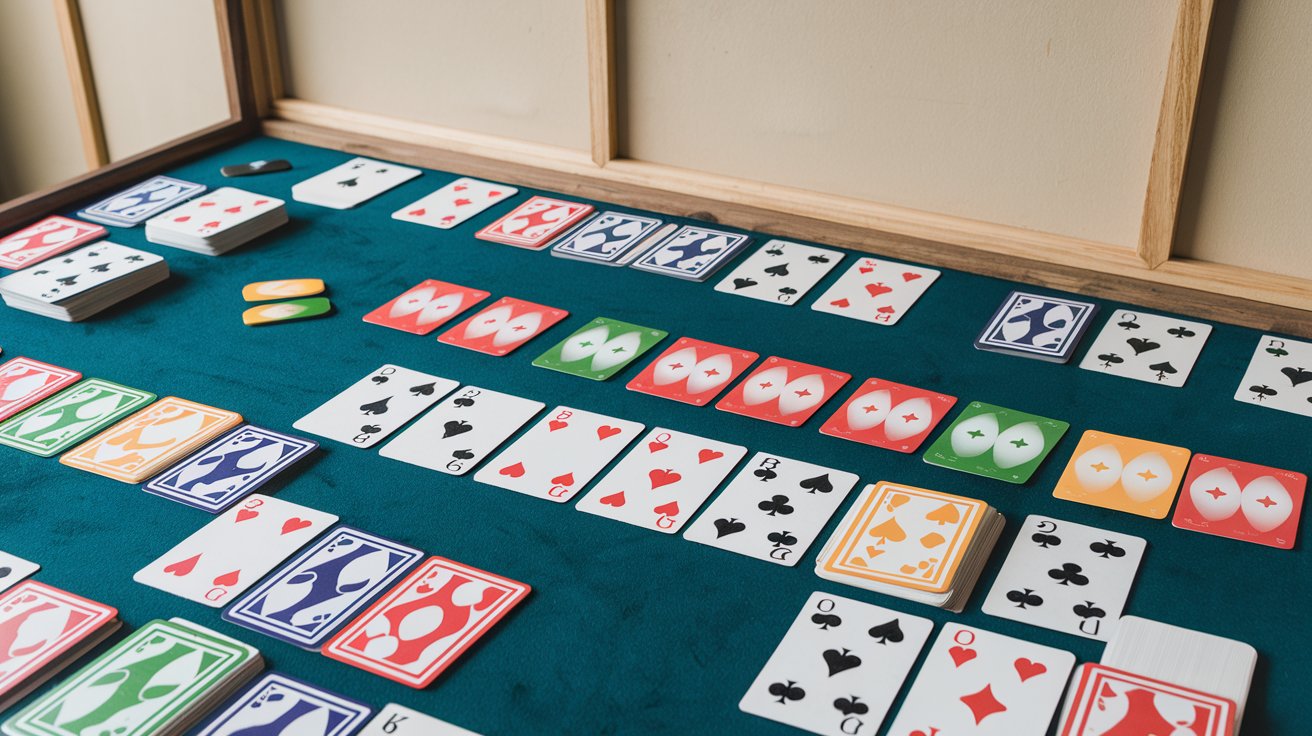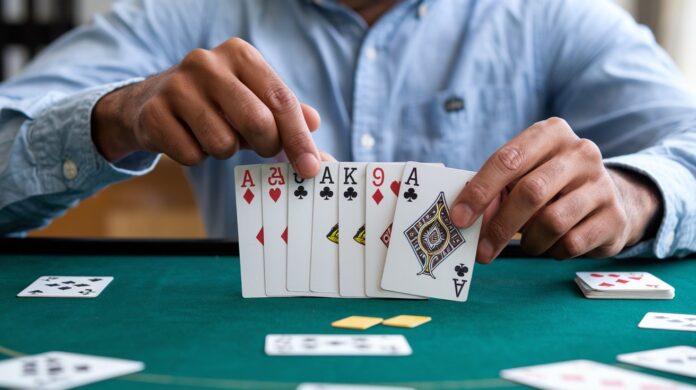In the fast-paced world of Rummy, success isn’t determined by luck alone—it’s a delicate dance between offense and defense. Mastering this balance is key to outsmarting your opponents, controlling the pace of the game, and ultimately clinching victory. Whether you’re a casual player or a competitive enthusiast, understanding how to effectively switch between aggressive plays and cautious moves can elevate your Rummy game to new heights.
Introduction: The Dual Nature of Rummy

Rummy is a game that elegantly combines skill, strategy, and a hint of psychology. Every move you make has a dual purpose—either advancing your own winning strategy or preventing your opponents from capitalizing on their hand. This duality makes Rummy not only a game of assembling melds but also a contest of wits where timing and adaptability reign supreme.
To win consistently, you must learn when to press forward with aggressive plays and when to hold back and defend. The art of balancing offense and defense isn’t just about managing your cards; it’s about reading the game, predicting your opponents’ moves, and making decisions that tip the scales in your favor.
SEO Keywords: Rummy strategy, balance offense and defense in Rummy, win at Rummy, advanced Rummy tactics
Understanding the Fundamentals of Rummy
Before diving into advanced strategies, it’s essential to revisit the core principles of Rummy:
-
Melds and Sequences: In Rummy, the goal is to form valid sets (cards of the same rank) or sequences (consecutive cards of the same suit). The sooner you complete these melds, the closer you are to winning.
-
Discarding and Drawing: Every turn involves drawing a card and discarding one. Your decisions during these phases can either boost your strategy or provide opportunities for your opponents.
-
Risk Management: Every card in your hand has potential value. Recognizing which cards contribute to your winning strategy and which are liabilities is a continuous process.
A strong foundation in these basics sets the stage for the more nuanced balance between offense and defense. In every game, you’re not just playing your hand—you’re managing risk while actively seeking to outmaneuver your opponents.
SEO Keywords: Rummy fundamentals, Rummy basics, Rummy card game, Rummy rules
Offensive Rummy: When to Push Forward

An offensive approach in Rummy involves taking bold actions to rapidly form melds and force your opponents into a reactive position. Here’s how to seize the initiative:
Aggressive Meld Formation
-
Rapid Assembly: When you have the opportunity to complete a meld, do so quickly. Aggressive meld formation puts pressure on your opponents and limits their options.
-
Capitalizing on Opportunities: If you see a card that can either complete your sequence or set, prioritize picking it up—even if it means taking a calculated risk.
-
Overlapping Cards: Some cards serve dual purposes, belonging to both potential sequences and sets. Identify these versatile cards early and build your hand around them.
Example: If you’re close to forming a sequence in hearts and you draw a crucial card from the deck, don’t hesitate to reveal that sequence. The momentum you create can force your opponents to discard more defensively, shifting the game’s dynamic in your favor.
Seizing Opportunities Early
The earlier you can establish your winning pattern, the more control you have over the game’s tempo. Offensive play is about setting the pace:
-
Initiate Early Aggression: Begin the game with a proactive mindset. Early in the game, use your initial hand strength to establish melds quickly.
-
Maintain Pressure: Once you start forming melds, keep the pressure on by making confident plays. This approach can unsettle your opponents, making them more prone to mistakes.
-
Prevent Counterplay: By being aggressive, you reduce the time your opponents have to develop their own strategies. This minimizes the chances they get to build strong melds.
SEO Keywords: aggressive Rummy play, offensive Rummy tactics, forming melds quickly, early game Rummy strategy
Defensive Rummy: Protecting Your Hand

While offense propels you toward victory, defense safeguards your progress and minimizes risks. A defensive strategy focuses on preserving valuable cards and thwarting your opponents’ attempts to steal the show.
Smart Discarding
Your discards are just as critical as your draws:
-
Avoid Giving Clues: Discard cards that are less likely to help your opponents complete their melds. For example, if you know a particular suit is in high demand, avoid discarding related cards.
-
Minimize Risk: Even if a card isn’t currently useful in your strategy, consider its potential value to your opponents. A defensive discard minimizes the chance of inadvertently giving away a winning card.
-
Consider the Discard Pile: Always keep an eye on the discard pile. Understanding what has already been played can help you decide which cards are safest to discard.
Blocking Opponents’ Moves
Defense in Rummy isn’t purely passive—it can also be highly strategic:
-
Retain Key Cards: Sometimes, holding onto a card might be the best way to prevent an opponent from completing a meld. This is particularly true if you suspect they’re building a sequence or set.
-
Control the Pace: By playing defensively, you force your opponents to take risks. When they’re unsure of their strategy, they’re more likely to make mistakes.
-
Disrupt Their Rhythm: A well-timed defensive move, such as discarding a card that might be critical to an opponent, can disrupt their game flow and force them into a less advantageous position.
SEO Keywords: defensive Rummy play, smart discarding, blocking moves in Rummy, defensive strategies in Rummy
Balancing Offense and Defense: Strategies for Every Game
The key to becoming a formidable Rummy player lies in knowing when to be aggressive and when to adopt a more cautious approach. Balancing offense and defense is about reading the game and your opponents, and adjusting your strategy accordingly.
Reading the Table and Your Opponents
Successful Rummy players are always aware of the broader picture:
-
Observe Discard Patterns: Pay close attention to what cards your opponents discard and which ones they pick up. This information is invaluable in determining their strategy.
-
Assess Hand Strength: While you can’t see your opponents’ hands, you can gauge their confidence by their actions. A player who is consistently discarding high-value cards might be on the defensive, whereas someone making bold plays may be on the offensive.
-
Adapt Based on Flow: If the game is moving quickly and your opponents are aggressively forming melds, it might be time to switch to defense. Conversely, if the game is slow and your opponents are cautious, you can afford to push the offense.
Adapting Your Strategy in Real-Time
Flexibility is the hallmark of a great Rummy player:
-
Continuous Assessment: Constantly evaluate the state of the game. Are you leading, or is an opponent starting to catch up? Adjust your tactics accordingly.
-
Switching Gears: Don’t be afraid to change your approach mid-game. If you start on offense but notice that your strategy is being countered, shift to defense to protect your hand and regroup.
-
Exploiting Opportunities: The game’s dynamics are always in flux. A defensive move might suddenly open up an opportunity for an aggressive play, and vice versa. Stay alert and be ready to take advantage of these moments.
SEO Keywords: balancing offense and defense, adaptive Rummy strategy, reading opponents in Rummy, flexible Rummy tactics
Advanced Techniques for Balancing Offense and Defense
For players looking to refine their strategy further, advanced techniques can help you seamlessly switch between offensive and defensive modes.
Psychological Warfare and Bluffing
The mental aspect of Rummy is as critical as the physical handling of cards:
-
Feign Weakness or Strength: Sometimes, your opponents’ perceptions of your hand can work to your advantage. By occasionally bluffing—playing as if your hand is weaker or stronger than it really is—you can manipulate the game’s psychology.
-
Misdirection: Use selective discards and bold moves to confuse your opponents. If they’re not sure whether you’re playing aggressively or defensively, they’re less likely to make optimal decisions.
-
Confidence is Contagious: A confident player can often unsettle even the most seasoned opponents. By balancing your play and occasionally mixing up your tactics, you send a message that you’re in control, regardless of the actual state of your hand.
Time Management and Decision-Making
Speed and timing are critical in competitive Rummy:
-
Quick but Calculated Decisions: While it’s important to take your time to assess the game, hesitating too long can give your opponents an edge. Learn to make decisions swiftly, but always with the bigger picture in mind.
-
Reading the Clock: In tournament settings, time management becomes crucial. Recognize when you need to speed up your play to maintain momentum and when a more deliberate approach is warranted.
-
Practice Under Pressure: Simulated games with time constraints can help you improve your decision-making speed without sacrificing strategic depth.
SEO Keywords: advanced Rummy techniques, Rummy psychological tactics, time management in Rummy, decision-making in competitive Rummy
Practice Drills to Improve Your Rummy Strategy
Like any skill, the ability to balance offense and defense in Rummy is honed through practice and self-reflection. Here are some drills and exercises to sharpen your strategic edge:
Simulated Game Scenarios
-
Controlled Practice Sessions: Set up games where you focus solely on either offensive or defensive play. This helps you understand the strengths and weaknesses of each approach.
-
Role Reversal: Occasionally play as if you’re your opponent. By taking the other side, you gain insights into what moves might trigger certain reactions from your adversaries.
-
Timed Drills: Practice with a timer to simulate the pressure of competitive play. This will help you learn to make quick, effective decisions without overthinking each move.
Memory and Observation Drills
-
Card Counting Exercises: Improve your ability to track discarded and drawn cards. Knowing what’s out there can inform both your offensive and defensive moves.
-
Pattern Recognition: Review past games and try to identify patterns in your opponents’ play. This reflection can help you anticipate their moves in future games.
-
Feedback Loops: Record your games if possible, then analyze your decision-making process. Identify moments where you could have switched gears—either pushing more aggressively or defending more wisely.
Mental Conditioning
-
Mindfulness Practices: Enhance your focus through meditation or mindfulness exercises. A clear mind will allow you to see the subtleties in the game and make better strategic choices.
-
Visualization Techniques: Before a game, visualize various scenarios where you need to switch between offense and defense. This mental rehearsal can prepare you to adapt quickly in real matches.
SEO Keywords: Rummy practice drills, improve Rummy strategy, Rummy training exercises, mental conditioning for Rummy
Conclusion: Achieve Mastery in Rummy
Balancing offense and defense in Rummy is more than just a tactical decision—it’s a strategic art that involves constant adaptation, psychological insight, and precise execution. By understanding when to attack and when to protect your hand, you can control the flow of the game, thwart your opponents’ plans, and create a winning path for yourself.
Key Takeaways
-
Dual Focus: A winning Rummy strategy requires an equal emphasis on offensive plays that build melds quickly and defensive tactics that block your opponents.
-
Read the Game: Success depends on your ability to observe, remember, and adapt. Paying close attention to card patterns, opponent behavior, and game flow is essential.
-
Flexibility is Crucial: The best players know when to shift gears. Don’t be afraid to change your approach mid-game based on the evolving dynamics.
-
Practice and Reflection: Regularly engaging in simulated games, memory drills, and mindfulness exercises can significantly improve your ability to balance offense and defense.
By integrating these strategies into your gameplay, you’re not just reacting to the cards—you’re proactively shaping the outcome of each round. Whether you’re competing in a high-stakes tournament or enjoying a casual game with friends, mastering this balance will set you apart as a truly formidable Rummy player.
Call to Action:
Ready to take your Rummy strategy to the next level? Start incorporating these techniques into your practice sessions and observe the difference they make. Join online communities, share your experiences, and learn from other passionate players. Remember, the key to mastery lies in continuous improvement and the willingness to adapt.
Happy playing, and may every hand you play bring you one step closer to becoming a Rummy champion!

Zareb Saleh is a journalist at Gulf Today and a ghostwriter for Gameoholic, specializing in gaming, technology, and digital culture. With a keen eye for industry trends, he delivers insightful stories that engage and inform readers.




